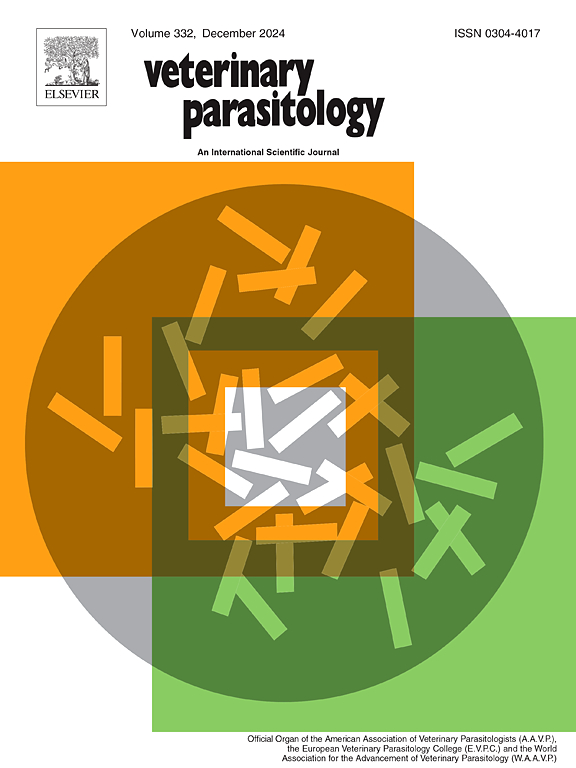两种单基因感染鱼类鳃中宿主-寄生虫相互作用和微生物群变化的整合RNA-Seq分析
IF 2
2区 农林科学
Q2 PARASITOLOGY
引用次数: 0
摘要
单系感染损害鱼类健康,对水产养殖构成重大威胁。这些寄生虫可造成严重的组织损伤并增加死亡率。白鲷(Centropomus viridis)和金头海鲷(Sparus aurata)是两种具有重要商业价值的鱼类,它们在感染单系菌后容易患病。了解宿主对感染反应的分子机制对于制定有效的疾病管理策略至关重要。在这项研究中,我们分别利用感染单基因病毒横纹肌病毒和金蛹Sparicotyle chrysophrii的C. viridis和S. aurata的转录组数据集进行了综合RNA-Seq分析。这些数据集来源于三项研究,使我们能够研究宿主基因表达变化、单基因基因激活和与感染相关的微生物群转移。我们对鳃微生物群的分析揭示了感染和未感染鱼之间细菌组成的显著变化。在病毒弧菌和金黄色葡萄球菌的微生物群中,感染鱼中有8个细菌科丰富,而未感染鱼中分别有11个和4个细菌科丰富。在单基因生物中,所有生物项目共有的分子机制包括细胞外基质组织、蛋白质水解和糖异生,这些过程可能涉及寄生虫在宿主体内的定植和生存。在鱼类中,我们的分析发现了aurata和C. viridis之间共享的分子机制,包括氧载体活性、细胞因子调节、细菌反应和钙粘蛋白介导的粘附,突出了宿主免疫系统、微生物群和寄生虫之间复杂的相互作用。这些发现增强了我们对鱼类-微生物群-寄生虫相互作用的理解,并为改进水产养殖疾病控制策略提供了有价值的观点。本文章由计算机程序翻译,如有差异,请以英文原文为准。
Integrative RNA-Seq analysis of host-parasite interactions and microbiota shifts in the gills of two fish species infected with monogeneans
Monogenean infections represent a significant threat to aquaculture by compromising fish health. These parasites can cause severe histological damage and increase mortality rates. The white snook (Centropomus viridis) and the gilthead seabream (Sparus aurata) are two commercially important fish species that become susceptible to diseases when infected with monogeneans. Understanding the molecular mechanisms underlying host responses to infection is essential for developing effective disease management strategies. In this study, we performed an integrative RNA-Seq analysis using transcriptomic datasets from C. viridis and S. aurata infected with the monogeneans Rhabdosynochus viridisi and Sparicotyle chrysophrii, respectively. These datasets originate from three studies, allowing us to investigate host gene expression changes, monogenean gene activation, and microbiota shifts associated with infection. Our analysis of the gill microbiota revealed significant alterations in bacterial composition between infected and uninfected fish. In the microbiota of both C. viridis and S. aurata, eight bacterial families were more abundant in infected fish, whereas eleven and four families, respectively, were more abundant in uninfected fish. In monogeneans, the molecular mechanisms shared across all Bioprojects included extracellular matrix organization, proteolysis, and gluconeogenesis, processes that may be involved in parasite colonization and survival within the host. In fish, our analysis identified shared molecular mechanisms between S. aurata and C. viridis, including oxygen carrier activity, cytokine regulation, bacterial response, and cadherin-mediated adhesion, highlighting a complex interplay between the host immune system, microbiota, and parasite. These findings enhance our understanding of fish-microbiome-parasite interactions and offer valuable perspectives for improving disease control strategies in aquaculture.
求助全文
通过发布文献求助,成功后即可免费获取论文全文。
去求助
来源期刊

Veterinary parasitology
农林科学-寄生虫学
CiteScore
5.30
自引率
7.70%
发文量
126
审稿时长
36 days
期刊介绍:
The journal Veterinary Parasitology has an open access mirror journal,Veterinary Parasitology: X, sharing the same aims and scope, editorial team, submission system and rigorous peer review.
This journal is concerned with those aspects of helminthology, protozoology and entomology which are of interest to animal health investigators, veterinary practitioners and others with a special interest in parasitology. Papers of the highest quality dealing with all aspects of disease prevention, pathology, treatment, epidemiology, and control of parasites in all domesticated animals, fall within the scope of the journal. Papers of geographically limited (local) interest which are not of interest to an international audience will not be accepted. Authors who submit papers based on local data will need to indicate why their paper is relevant to a broader readership.
Parasitological studies on laboratory animals fall within the scope of the journal only if they provide a reasonably close model of a disease of domestic animals. Additionally the journal will consider papers relating to wildlife species where they may act as disease reservoirs to domestic animals, or as a zoonotic reservoir. Case studies considered to be unique or of specific interest to the journal, will also be considered on occasions at the Editors'' discretion. Papers dealing exclusively with the taxonomy of parasites do not fall within the scope of the journal.
 求助内容:
求助内容: 应助结果提醒方式:
应助结果提醒方式:


